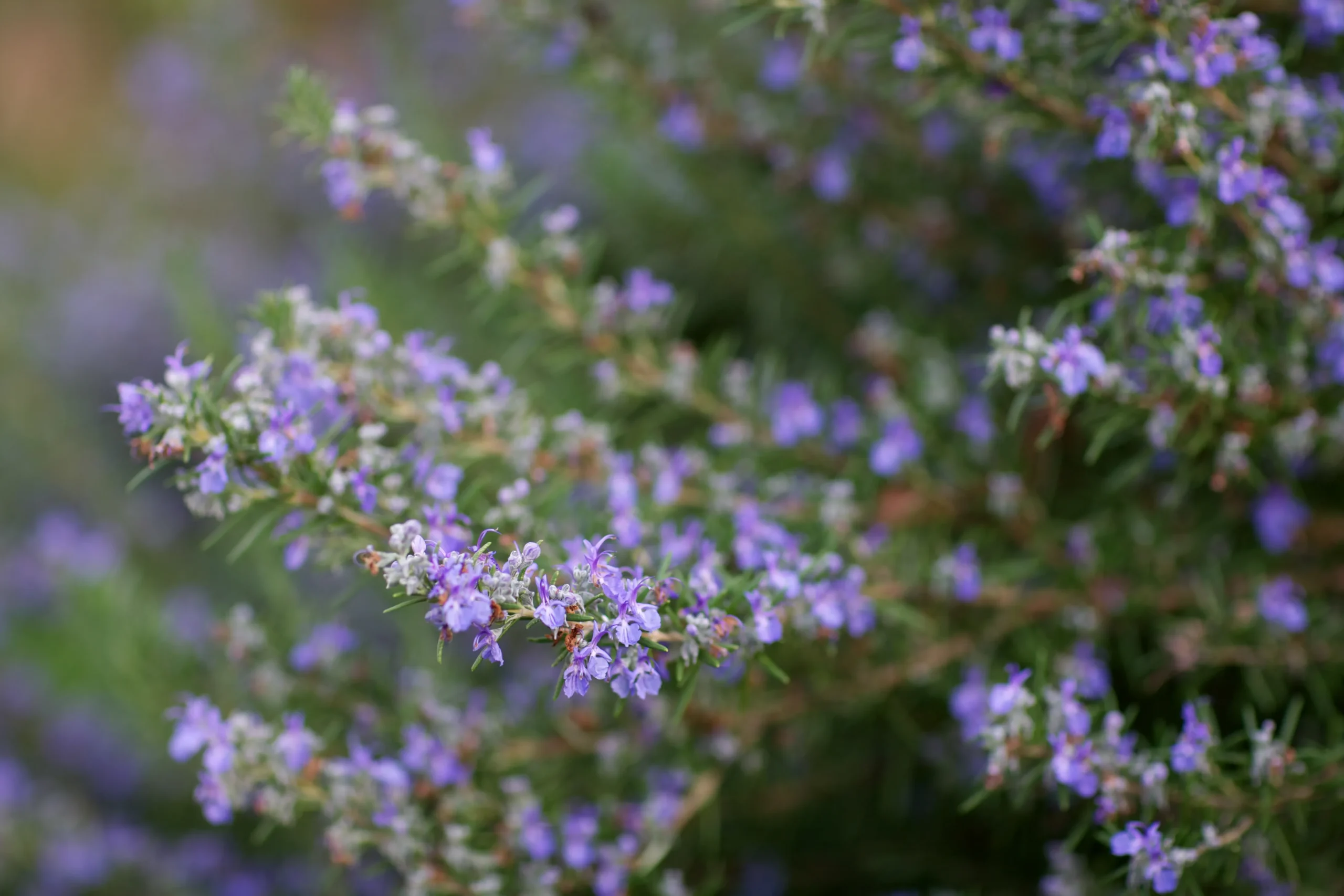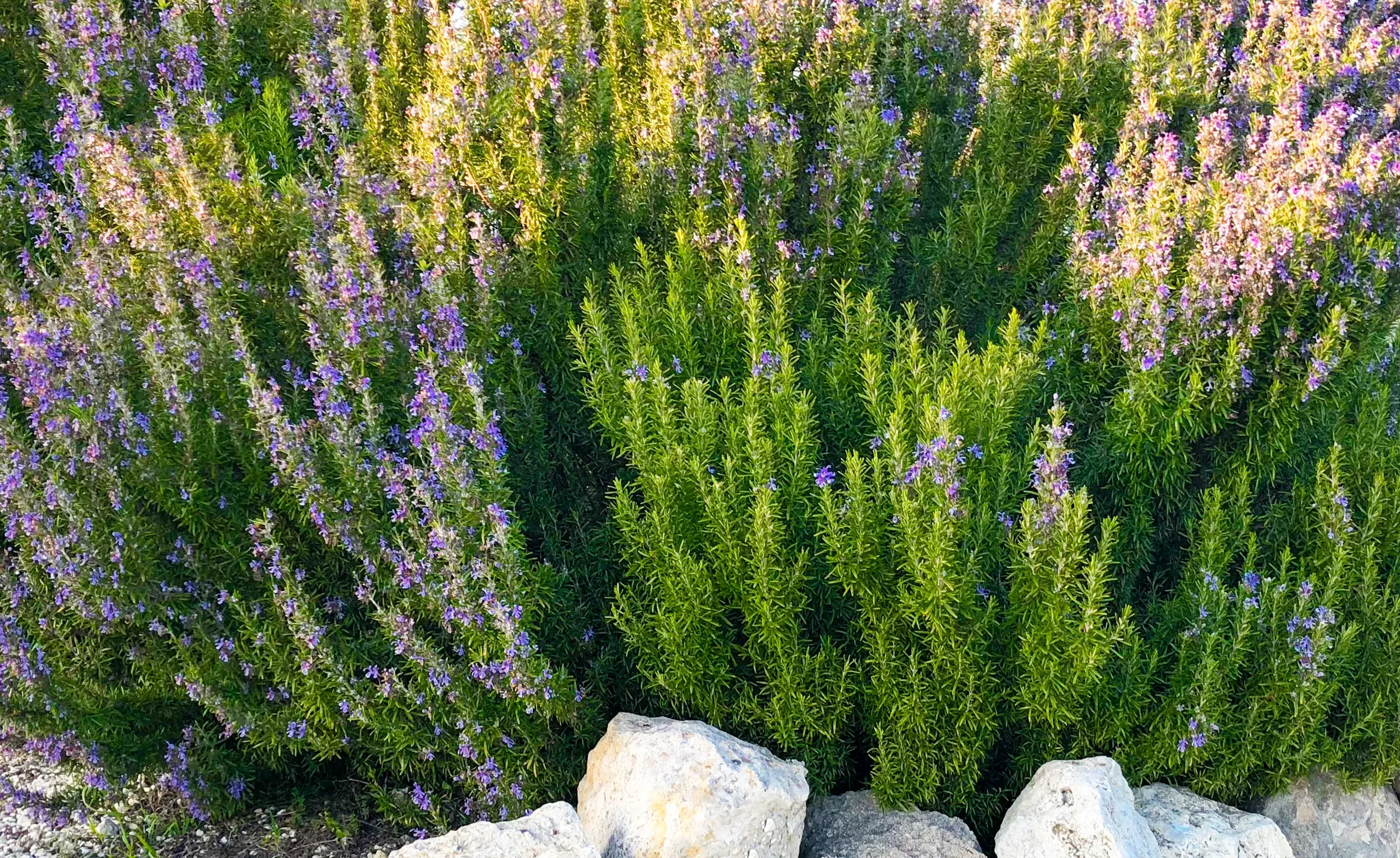Family: Rosemary
Type: Herb

Tuscan Blue Rosemary is a culinary and ornamental marvel, cherished for its aromatic foliage and striking blue flowers. This evergreen herb adds both flavor to dishes and visual appeal to gardens, making it a dual-purpose plant. Its upright growth habit and lush, needle-like leaves create a vibrant green backdrop, while the profusion of blue flowers in spring and summer brings a splash of color.
Adaptable and hardy, Tuscan Blue Rosemary thrives in full sun and well-drained soil, showcasing its drought-tolerant nature. It’s a perfect choice for gardeners seeking low-maintenance plants that offer year-round interest. Growing up to 4-6 feet tall, it can serve as an excellent hedge or privacy screen, besides being a delightful addition to culinary gardens.
The fragrant leaves of Tuscan Blue Rosemary not only enhance a variety of dishes but also attract pollinators like bees and butterflies, adding to the biodiversity of your garden. Whether planted in the ground or in containers, this rosemary variant is a standout, bringing the essence of the Mediterranean to any outdoor space.
Hardiness Zone: 7b-10b
Deer Resistant: Yes
Pet Friendly: Yes
Moisture Preference: Dry to average
Sun Needs: Full sun
Growth Rate: Medium
Average Height (feet): 6
Average Spread (feet): 4
Average Life Span (years): 10
Form: Upright spreading
Flower Color: Blue
Bloom Season: From early spring to early summer
Foliage Color: Green
Foliage Shape: Needle
Incorporating Tuscan Blue Rosemary into your landscape design offers both aesthetic and practical benefits. Its upright growth and dense foliage make it ideal for creating natural borders or defining garden pathways. As a low hedge, it provides structure while infusing the area with its pleasant aroma.
Pairing Tuscan Blue Rosemary with other Mediterranean plants, such as lavender and thyme, creates a harmonious, drought-tolerant garden that’s low on maintenance but high on sensory appeal. The contrast of colors and textures between these plants can turn a garden into a visually stunning and aromatic retreat.
For those with limited space, Tuscan Blue Rosemary excels in container gardening. It adapts well to pots, allowing you to enjoy its fragrant foliage and vibrant flowers on patios, balconies, or as a kitchen garden right outside your door. Container planting also facilitates easy access for culinary use, making it a practical choice for home cooks.

Tuscan Blue Rosemary is a staple in Mediterranean garden designs, where its drought tolerance and evergreen nature embody the landscape's aesthetic and functional qualities.
In culinary gardens, Tuscan Blue Rosemary serves a dual purpose as both a key ingredient for various dishes and an attractive, aromatic plant that enhances the garden's beauty.
For modern gardens, Tuscan Blue Rosemary offers a touch of greenery that is both stylish and easy to care for, fitting perfectly into sleek, contemporary designs with its structured form and vibrant blooms.
Create an aromatic entryway by planting Tuscan Blue Rosemary along walkways or at the entrance to your home. Its fragrant foliage welcomes guests with a pleasant scent, while its flowers add a touch of color.
Design a sensory garden by incorporating Tuscan Blue Rosemary with other aromatic and tactile plants. The variety of scents and textures engages the senses, creating a relaxing and immersive garden experience.
Use Tuscan Blue Rosemary as a natural pest repellent in vegetable and herb gardens. Its aromatic oils help deter certain pests, making it a functional companion plant that also contributes to the garden’s overall health and productivity.
Select our pre-made garden layouts to create a landscape that’s uniquely yours. Simple, smart, and customizable!
In spring, Tuscan Blue Rosemary bursts into bloom, displaying its vivid blue flowers that attract pollinators and add a dash of color to the garden.
During summer, the plant continues to flourish, with lush green foliage that stands strong against the heat, providing a continuous aromatic backdrop.
As fall arrives, Tuscan Blue Rosemary maintains its greenery, offering a lasting visual appeal even as other plants begin to fade.
In winter, Tuscan Blue Rosemary remains evergreen, adding structure and color to the garden landscape, and proving itself as a resilient plant throughout the year.
Choose a sunny spot for your Tuscan Blue Rosemary, as it thrives in full sun. It’s perfect for gardens that get direct sunlight for most of the day.
This herb loves the sun, requiring at least 6 to 8 hours of direct sunlight daily to flourish and produce abundant blooms.
Well-drained, sandy or loamy soil is ideal. Tuscan Blue Rosemary prefers a slightly acidic to neutral pH but is quite adaptable and can tolerate poor soil conditions.
Space plants 2 to 3 feet apart to allow for proper air circulation and room to grow, preventing overcrowding and promoting healthy development.
The best time to plant Tuscan Blue Rosemary is in the spring after the last frost, giving it plenty of time to establish roots before the winter.
Dig a hole that is as deep as the root ball and twice as wide. Place the plant in the hole, backfill with soil, water thoroughly, and apply a light layer of mulch to retain moisture.
Tuscan Blue Rosemary is drought-tolerant once established, requiring only occasional watering during extended dry periods.
Generally, Tuscan Blue Rosemary does not need fertilizer. If growth seems sluggish, apply a light application of a balanced, all-purpose fertilizer in early spring.
Prune in early spring to encourage bushy growth and remove any dead or woody stems. Light pruning after flowering helps maintain its shape.
Mulch lightly and water as needed. Prune to shape the plant and encourage lush, new growth.
Water sparingly, only during prolonged dry spells. Tuscan Blue Rosemary can handle the heat without much additional care.
Prepare the plant for winter by reducing watering and ensuring it is not in waterlogged soil, which can cause root rot.
No special winter care is needed in warmer climates. In colder regions, protect the plant with mulch or bring container-grown plants indoors.
In zones 7 and above, Tuscan Blue Rosemary can typically survive winter outdoors. In colder zones, it may need protection or to be grown in containers and brought inside.
With proper care, Tuscan Blue Rosemary can live and continue to produce for several years, often growing larger and more robust with age.
Yes, Tuscan Blue Rosemary can be grown indoors in a pot, provided it receives enough sunlight, ideally from a south-facing window, and is not overwatered.
Sign up below to get exclusive deals, discounts, and new plant collections—delivered straight to your inbox! Plus, stay inspired with the latest gardening tips, landscaping trends, and DIY garden ideas. Start growing with us today!
A big thank you for subscribing to the PBN Design newsletter.
We're thrilled to have you join our community. Get ready for exciting updates, insightful content, and more delivered straight to your inbox.
Stay tuned!
Go backA big thank you for subscribing to the PBN Design newsletter.
We're thrilled to have you join our community. Get ready for exciting updates, insightful content, and more delivered straight to your inbox.
Stay tuned!
Go back